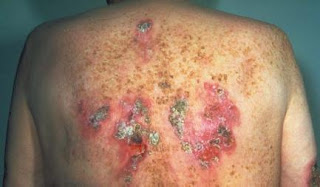Nursing Diagnosis for Gonorrhea
Gonorrhea is a sexually transmitted disease (STD) caused by bacteria called Neisseria gonorrhoeae. The bacteria can be passed from one person to another through vaginal, oral, or anal sex, even when the person who is infected has no symptoms. It can also be passed from a mother to her baby during birth. You cannot catch gonorrhea from a towel, a doorknob, or a toilet seat.
Gonorrhea does not always cause symptoms, especially in women. In men, gonorrhea can cause pain when urinating and discharge from the penis. If untreated, it can cause epididymitis, which affects the testicles and can lead to infertility. In women, gonorrhea can cause bleeding between periods, pain when urinating and increased discharge from the vagina. If untreated, it can lead to pelvic inflammatory disease, which causes problems with pregnancy and infertility. Gonorrhea can pass from mother to baby during pregnancy.
Gonorrhea symptoms in women
- Greenish yellow or whitish discharge from the vagina
- Lower abdominal or pelvic pain
- Burning when urinating
- Conjunctivitis (red, itchy eyes)
- Bleeding between periods
- Spotting after intercourse
- Swelling of the vulva (vulvitis)
- Burning in the throat (due to oral sex)
- Swollen glands in the throat (due to oral sex)
Gonorrhea symptoms in men
- Greenish yellow or whitish discharge from the penis
- Burning when urinating
- Burning in the throat (due to oral sex)
- Painful or swollen testicles
- Swollen glands in the throat (due to oral sex)
Nursing Diagnosis for Gonorrhea 1.
Acute Pain related to the reaction of infection
Goal:
After nursing actions, the client will:
- Identifying the causes
- Using the methods of prevention of non-analgesic to relieve pain
- Using analgesics as needed
- Reported pain was controlled
Nursing Interventions: Acute Pain - Nursing Care Plan for Gonorrhea:
- Examine in a comprehensive pain include location, characteristics, and onset, duration, frequency, quality, intensity / severity of pain, and precipitation factors.
- Observation of non-verbal cues of discomfort, especially the inability to communicate effectively.
- Use therapeutic communication so that the client can express pain.
- Provide support to clients and families
- Control of environmental factors that can affect the client's response to discomfort (ex.: room temperature, irradiation, etc.)
- Teach the use of non-pharmacologic techniques (ex.: relaxation, guided imagery, music therapy, distraction, application of heat and cold, massage, hypnosis, therapeutic activity)
- Give analgesics as ordered
- Increase enough sleep or rest
- Evaluate the effectiveness of the measures that have been used to control pain.
Nursing Diagnosis for Gonorrhea 2.
Hyperthermia related to inflammatory reactions
Goal:
After nursing actions, the client will:
- The temperature in the normal range
- Pulse and respiration within the normal range
- No skin discoloration and no headache
Nursing Interventions: Hyperthermia - Nursing Care Pla for Gonorrhea
- Monitor vital sign
- Monitor the temperature at least 2 hours
- Monitor skin color.
- Increase fluid intake and nutrition
- Cover the client to prevent loss of body heat
- Compress clients in the groin and axilla
- Give antipyretics as needed.
Nursing Diagnosis for Gonorrhea 3.
Impaired Urinary Elimination related to the inflammatory process
Goal:
After nursing actions, the client will:
- Elimination of urine would not be disturbed: the smell, the number, color of urine within expected ranges and urine output without pain
Nursing Interventions: Impaired Urinary Elimination - Nursing Care Pla for Gonorrhea
- Monitor urine elimination include: frequency, consistency, odor, volume, and color appropriately
- Refer to urologist if the cause of acute discovered.
Nursing Diagnosis for Gonorrhea 4.
Anxiety related to the disease
Goal:
After nursing actions, the client will:
- No signs of anxiety
- Reported a decrease in the duration and episodes of anxiety
- Reporting needs adequate sleep
- Demonstrate flexibility role
Nursing Interventions: Anxiety - Nursing Care Pla for Gonorrhea
- Assess the level of anxiety and physical reactions to high levels of anxiety (tachycardia, tachypnea, non-verbal expressions of anxiety)
- Accompany clients to support the anxiety and fear
- Instruct client to use relaxation techniques
- Give medication to reduce anxiety in a proper way
- Provide current information on the diagnosis, treatment, and prognosis
